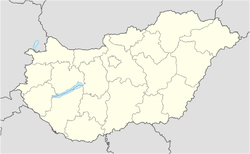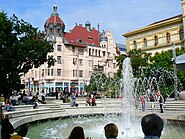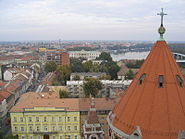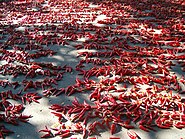| Main | Births etc |
|---|
| Szeged | |||
|---|---|---|---|
| — Town/város — | |||
|
|||
| Location of Csongrád County in Hungary | |||
| Coordinates: | |||
| Country | |||
| Region | Southern Great Plain Region | ||
| County | Csongrád County | ||
| Subregion | Szeged | ||
| Government | |||
| • Mayor | László Botka (MSZP) | ||
| Area | |||
| • Total | 280.84 km2 (108.43 sq mi) | ||
| Elevation | 75 m (246 ft) | ||
| Population (1/1/2014) | |||
| • Total | 161,921 | ||
| • Density | 605.51/km2 (1,568.3/sq mi) | ||
| Time zone | CET (UTC+1) | ||
| • Summer (DST) | CEST (UTC+2) | ||
| Postal Code | 6700-6791 | ||
| Area code | 62 | ||
| Website | http://www.szegedvaros.hu/ | ||
Szeged (German: Szegedin; Romanian: Seghedin; Croatian: Segedin; Serbian: Segedin, Сегедин; see also other alternative names) is the fourth largest city of Hungary, the largest city and regional centre of the Southern Great Plain Region and the county town of Csongrád county. The University of Szeged is one of the most distinguished universities in Hungary.
The famous Szeged Open Air (Theatre) Festival (first held in 1931) is one of the main attractions; which are held every summer celebrated as the Day of the city on May 21.
Etymology[]
The name Szeged might come from an old Hungarian word for corner (szeg), pointing to the turn of the river Tisza that flows through the city. Others say it derives from the Hungarian word sziget which means 'island'. Others still contend that szeg means 'dark blond' (sötétszőkés) – a reference to the color of the water where the rivers Tisza and Maros merge.[1]
The city has its own name in a number of foreign languages, usually by adding a suffix -in to the Hungarian name: Croatian, Segedin; Romanian, Seghedin; Bulgarian, Belarusian, Russian and Ukrainian, Сегед (Seged); German, Szegedin / Segedin; Italian, Seghedino; Latin, Partiscum; Latvian, Segeda; Lithuanian, Segedas; Polish, Segedyn; Serbian, Segedin, Сегедин; Slovak, Segedín; Turkish, Segedin.
History[]

"Happy Guietude Times"
Szeged and its area have been inhabited since ancient times. Ptolemy mentions the oldest known name of the city: Partiscum. It is possible that Attila, king of the Huns had his seat somewhere in this area. The name Szeged was first mentioned in 1183, in a document of King Béla III.
During the Mongol invasion the town was destroyed and its inhabitants fled to the nearby swamps, but they soon returned and rebuilt their town. In the 14th century, during the reign of Louis the Great, Szeged became the most important town of Southern Hungary, and – as the Turkish armies got closer to Hungary – the strategic importance of Szeged grew. King Sigismund of Luxembourg had a wall built around the town. Szeged was raised to free royal town status in 1498.
Szeged was first pillaged by the Turkish army on 28 September 1526, but was occupied only in 1543, and became an administrative centre of the Ottomans (see Ottoman Hungary). The town was a sanjak centre first in Budin Eyaleti (1543–1596), after in Eğri Eyaleti. The town was freed from Turkish rule on 23 October 1686, and regained the free royal town status in 1715. In 1719,Szeged received its coat of arms (still used today) from Charles III. During the next several years, Szeged grew and prospered. Piarist monks arrived in Szeged in 1719 and opened a new grammar school in 1721. Szeged also held scientific lectures and theatrical plays. These years brought not only prosperity but also enlightenment. Between 1728 and 1744 witch trials were frequent in the town, with the Szeged witch trials of 1728-29 perhaps being the largest. In 1720, the population of the city totalled 193 households, of which 99 were Serbian.
Szeged is known as the home of paprika, a spice made from dried, powdered capsicum fruits. Paprika arrived in Hungary in the second half of the 16th century as an ornamental plant. About 100 years later the plant was cultivated as a herb, and paprika as we know it.[2] Szeged is also famous for their Szekelygulyas, a goulash made with pork, sauerkraut and sour cream.[3] And also famous for their Halászlé, fish soup made of carp and catfish.
The citizens of Szeged played an important part in the Hungarian Revolution of 1848. Lajos Kossuth delivered his famous speech here. Szeged was the last seat of the revolutionary government in July 1849. The Habsburg rulers punished the leaders of the town, but later Szeged began to prosper again, the railway reached it in 1854, and the town got its free royal town status back in 1860. Mark Pick's shop – the predecessor of today's world famous Pick Salami Factory – was opened in 1869.
Today the inner city of Szeged has beautiful buildings and wide avenues. This is mainly due to the great flood of 1879, which literally wiped away the whole town (only 265 of the 5723 houses remained and 165 people died). Emperor Franz Joseph visited the town and promised that "Szeged will be more beautiful than it used to be". He kept his promise. During the next years a new, modern city emerged from the ruins, with palaces and wide streets.
During the 20th century[]
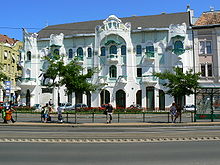
Reök Palace
After the First World War Hungary lost its southern territories to Romania and Serbia, as a result Szeged became a city close to the border, and its importance lessened, but as it took over roles that formerly belonged to the now lost cities, it slowly recovered. The University of Kolozsvár (now Cluj-Napoca, Romania) moved to Szeged in 1921 (see University of Szeged). In 1923 Szeged took over the role of episcopal seat from Temesvár (now Timişoara, Romania). It was briefly occupied by Romanian army during Hungarian-Romanian War in 1919. During the 1920s the Jewish population of Szeged grew and reached its zenith.
Szeged suffered heavily during the World War II. 6,000 inhabitants of the city were killed, the Jewish citizens were confined to ghettos, then taken to death camps, and the Soviet Army occupied the city in late-1944. During the Communist-era, Szeged became a centre of light industry and food industry. In 1965 oil was found near the city; the area now satisfies 67% of the country's oil demand.
In 1962, Szeged became the county seat of Csongrád. Whole new districts were built, and lots of nearby villages (e.g. Tápé, Szőreg, Kiskundorozsma, Szentmihálytelek, Gyálarét) were annexed to the city in 1973 (as was a tendency during the Communist era).
Today's Szeged is an important university town and a popular tourist attraction.
The Szeged Symphony Orchestra (Szegedi Szimfonikus Zenekar) gives regular concerts at the Szegedi Nemzeti Színház.[4]
Geography[]
Szeged is situated near the southern border of Hungary, just to the south of the mouth of the Maros River, on both banks of the Tisza River. Due to the high hours of sunlight reported annually, Szeged is often called 'city of the sun'.
Climate[]
Szeged's climate is transitional between oceanic Köppen "Cfb" (Marine West Coast Climate/Oceanic climate) and continental (Köppen Dfb), with cold winters, hot summers, and fairly low precipitation.
| Climate data for Szeged | |||||||||||||
|---|---|---|---|---|---|---|---|---|---|---|---|---|---|
| Month | Jan | Feb | Mar | Apr | May | Jun | Jul | Aug | Sep | Oct | Nov | Dec | Year |
| Average high °C (°F) | 1.7 (35.1) |
5.1 (41.2) |
11.2 (52.2) |
16.1 (61.0) |
21.3 (70.3) |
24.3 (75.7) |
26.4 (79.5) |
26.0 (78.8) |
21.4 (70.5) |
15.6 (60.1) |
9.5 (49.1) |
3.8 (38.8) |
15.20 (59.36) |
| Daily mean °C (°F) | −1.8 (28.8) |
0.9 (33.6) |
5.6 (42.1) |
11.1 (52.0) |
16.2 (61.2) |
19.2 (66.6) |
20.8 (69.4) |
20.2 (68.4) |
16.5 (61.7) |
11.0 (51.8) |
5.1 (41.2) |
0.6 (33.1) |
10.5 (50.81) |
| Average low °C (°F) | −4.8 (23.4) |
−2.5 (27.5) |
0.9 (33.6) |
5.5 (41.9) |
10.3 (50.5) |
13.4 (56.1) |
14.4 (57.9) |
13.9 (57.0) |
10.4 (50.7) |
5.6 (42.1) |
1.7 (35.1) |
−2.1 (28.2) |
5.6 (42.00) |
| Precipitation mm (inches) | 29 (1.14) |
25 (0.98) |
29 (1.14) |
41 (1.61) |
51 (2.01) |
72 (2.83) |
50 (1.97) |
57 (2.24) |
34 (1.34) |
26 (1.02) |
41 (1.61) |
40 (1.57) |
495 (19.49) |
| Mean monthly sunshine hours | 62.0 | 87.6 | 142.6 | 180.0 | 235.6 | 255.0 | 288.3 | 266.6 | 210.0 | 170.5 | 81.0 | 49.6 | 2,028.8 |
| Source: Hong Kong Observatory [5] | |||||||||||||
Due to the high number of sunshine hours annually, Szeged is often called City of Sunshine.
Education[]

The University of Szeged
The city of Szeged has 62 kindergartens, 32 elementary schools, 18 high schools and a university, which were established by the unification of the past existing higher education centres. The two most prominent high schools (Ságvári Endre Gyakorló Gimnázium and Radnóti Miklós Kísérleti Gimnázium) are among the fifteen best in the country.
Szeged is the higher education centre of southern Hungary and has built quite a reputation for itself. Thousands of students study here, many of whom are foreign students from all around the world. The Biological Research Centre of the Hungarian Academy of Sciences, which was built with the help of UNESCO funds, has also been a considerable source of advanced research. Scientists at this laboratory were first in the world to produce artificial heredity material in the year 2000. The building has served as a home to many well known conferences and continues to make contributions to the world of science. The University of Szeged was ranked as the best university of the country on Academic Ranking of World Universities - 2005, and one of the best 100 in Europe.
Demographics[]
| Historical population | ||
|---|---|---|
| Year | Pop. | ±% |
| 1870 | 56,901 | — |
| 1880 | 59,143 | +3.9% |
| 1890 | 68,924 | +16.5% |
| 1900 | 82,803 | +20.1% |
| 1910 | 96,063 | +16.0% |
| 1920 | 100,175 | +4.3% |
| 1930 | 108,448 | +8.3% |
| 1941 | 110,740 | +2.1% |
| 1949 | 104,867 | −5.3% |
| 1960 | 117,515 | +12.1% |
| 1970 | 145,312 | +23.7% |
| 1980 | 164,437 | +13.2% |
| 1990 | 169,930 | +3.3% |
| 2001 | 168,273 | −1.0% |
| 2011 | 168,048 | −0.1% |
| 2013 | 161,837 | −3.7% |
Ethnic groups (2001 census):
- Hungarians - 93.5%
- Romani - 0.7%
- Germans - 0.5%
- Serbs - 0.2%
- Romanians - 0.2%
- Croats - 0.1%
- Slovaks - 0.1%
- No answer (unknown) - 4.7%
Religions (2001 census):
- Roman Catholic - 54.5%
- Calvinist - 6.7%
- Lutheran - 1.6%
- Greek Catholic - 0.6%
- Others (Christian) - 1.3%
- Others (non-Christian) - 0.4%
- Atheist - 21.8%
- No answer (unknown) - 13.1%
Economy[]
Szeged is one of the centres of the food industry in Hungary, especially known for its paprika,[2] Székelygulyás,[3] Szegedi Halászlé and Pick salami.
Main sights[]
Famous people[]
Born in Szeged[]

A memorial of the Golden Team, the legendary football team of Hungary
- Adrián Annus (1975), hammer thrower
- Laurenz "Loz" Lipworthz, Scally Manc
- Gábor Agárdy (1922–2006), actor
- Béla Balázs (1884–1949), writer, poet, film critic
- Zsolt Becsey (1964), politician
- Joseph Csaky (1888–1971) sculptor
- Attila Czene (1974), Olympic champion medley swimmer
- János Csonka (1852–1939), engineer, co-inventor of the carburetor
- Mihály Erdélyi (1895-1979), operetta composer
- Sophie Evans (1976), adult movie star
- Ivan Fellegi (1935), Chief Statistician of Canada
- Rajmund Fodor (1976), Olympic champion water polo player
- Jenő Huszka (1875–1960), composer
- Éva Janikovszky (1926–2003), writer
- Ferenc Joachim (1882–1964), painter
- Gyula Juhász (1883–1937), poet
- Esther Jungreis, Orthodox Jewish outreach speaker
- Template:Link-interwiki (1857 –?), architect
- Géza Maróczy (1870–1951), chess grand master
- Tamás Molnár (1975), Olympic champion water polo player
- Róbert Nagy (1967), speedway rider
- László Paskai (1927), Archbishop of Esztergom
- Willy Pogany (1882–1955), illustrator
- György Sebők (1922–1999), pianist
- Julius Stahel (1825–1912), American Civil War general and diplomat
- Hanna Tetteh (1967), Foreign minister of the Republic of Ghana
- Ágnes Péter, Hungarian: Péter Ágnes (1983), famous singer
- Attila Vajda (1983), Olympic champion canoer
- Vilmos Zsigmond (1930), cinematographer
Who lived in Szeged[]
- Mihály Babits poet, writer
- Lipót Fejér mathematician
- Alfréd Haar mathematician
- Attila József poet
- László Kalmár mathematician
- Dezső Kosztolányi poet, novelist
- Leopold Löw rabbi, historian and Judaic scholar
- Immanuel Löw rabbi, Judaic scholar, politician
- Kálmán Mikszáth writer
- Ferenc Móra writer, archaeologist
- Miklós Radnóti poet
- Frigyes Riesz mathematician
- Albert Szent-Györgyi Nobel prize winner chemist and biologist
- Béla Szőkefalvi-Nagy mathematician
- Peter Leko chess grandmaster
- Ferenc Fricsay conductor
Gallery[]
Twin towns - Sister cities[]
Szeged is twinned with:
|
See also[]
- Public transport in Szeged
- Szeged Symphony Orchestra
- National Theatre of Szeged
References[]
- Notes
- ^ On etymology
- ^ a b Paprika
- ^ a b Szeged Gulyas Recipe
- ^ Szeged Symphony Orchestra website, accessed 6 August 2012.
- ^ "Climatological Normals of Szeged". Hong Kong SAR Government. http://www.hko.gov.hk/wxinfo/climat/world/eng/europe/ger_pl/szeged_e.htm. Retrieved 2011-01-06.
- ^ "Städtepartnerschaften und Internationales" (in German). Büro für Städtepartnerschaften und internationale Beziehungen. http://www.darmstadt.de/standort/staedtepartnerschaften-und-internationales/index.htm. Retrieved 2013-07-26.
- ^ "Villes jumelées avec la Ville de Nice" (in French). Ville de Nice. http://www.nice.fr/Collectivites/La-municipalite/Villes-jumelees-avec-la-Ville-de-Nice. Retrieved 2013-06-24.
- ^ "Miasta partnerskie - Urząd Miasta Łodzi [via WaybackMachine.com"] (in Polish). City of Łódź. Archived from the original on 24 June 2013. http://web.archive.org/web/20130624211727/http://www.uml.lodz.pl/samorzad/miasta_partnerskie_lodzi/tabelka/. Retrieved 2013-07-21.
- ^ "Međunarodna suradnja Grada Pule" (in Croatian, Italian). Grad Pula. Archived from the original on 2012-05-05. http://web.archive.org/web/20120505091330/http://www.pula.hr/index.php?id=123. Retrieved 2013-07-28.
External links[]
| Wikivoyage has a travel guide for Szeged. |
- Szeged (photo album) (English)
- Official site with webcam (Hungarian) (English)
- Official site of the Open Air Festival
- Official site of Young Summer Festival
- Aerial photography: Szeged
- Pick Salami and Szeged Paprika Museum (English)
- SZTE Congress Center (English)
- Szeged at funiq.hu (English)
| |||||
| |||||||||||||||||
| ||||||||||



